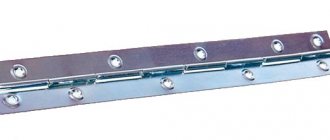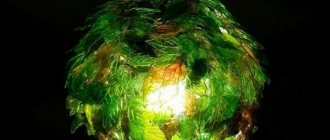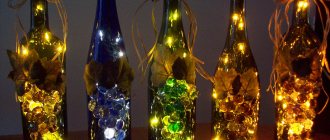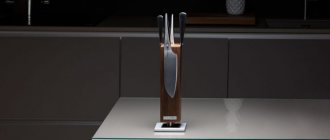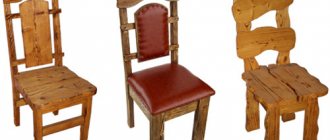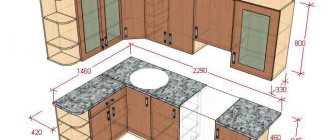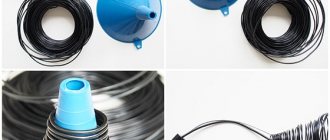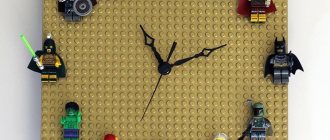If you are a lover of everything unusual and stylish, if you like to bring fresh ideas to life, then we suggest you make a chandelier from threads with your own hands. This master class will give impetus to your imagination and teach you a new technique that will help you create an unusual lamp. A few hours of work and your room will literally and figuratively shine with bright light, making you look up and see the reflection of the magical world in a beautiful hand-made lampshade made of threads.
Advantages of using a thread lampshade
The interweaving threads of the lampshade will create fancy shadows on the walls, drawing intricate laces that will tremble and sway from the slightest draft in the room. Warm, calm light will sprinkle small rays and draw smiles on the wallpaper and ceiling. Lightness and weightlessness, the measured swaying of the lamp will give peace and quiet joy, which is akin to light meditation on the shore of a warm, gentle sea.
Look through your yarn baskets and find threads that match the color and texture to match the color scheme of the room. Then your creation will live in a single ensemble with a common atmosphere, and complement and decorate the interior of the room.
Thread to thread, circle by circle... And before your eyes a unique pattern of colored yarn will be born. And you won’t be able to create a second work like this; each thread lampshade will be special and unique. Turn on the music, free your mind from unpleasant thoughts and immerse yourself in the meditative process...
Lock lamp
This solution is suitable for those who, as a child, loved to cut out pictures from magazines. A surprisingly simple lamp that will create a mysterious, almost mystical atmosphere in the room.
You will need to find a photograph (or print a picture) of an ancient castle, carefully cut it out and roll it into a kind of tube. Then secure the structure with tape and place a small light bulb inside. On dark evenings, your castle will be illuminated from the inside, and mysterious shadows will flicker against its background... well, how can you not tell a scary fairy tale? You can also cut out “windows” in the castle through which light will pour out.
Tools and materials for work
In every home you can find almost all the elements to create such a lampshade:
- For the basic shape of the chandelier, you can choose an inflatable balloon, a small ball or the frame of an old chandelier or sconce, you can also use an embroidery hoop.
- Cotton, linen, wool or mixed threads. White balls made of cotton threads look ideal, this is a win-win option. Choose yarn that matches the main colors of the walls and wallpaper, maybe 2-3 shades darker or lighter. And if you or your children love holidays, then choose bright, rich colors in contrast to the main color.
- Glue (PVA, transparent stationery) and varnish for covering a ball of thread.
- For the electrical part you need a cartridge and a stranded wire 15-20 cm long
- If you want to make a wall sconce, then to work you will need a stand for the sphere, a wire with a plug and a light switch. Consider the lampshade option before starting work.
- If you choose to make a pendant from several small balls, then purchase or take out a garland with light bulbs from the New Year's box.
DIY thread chandelier
- We inflate the balloon to the size we need and tie it well with thread. If it deflates, the shape of the lampshade will be sloppy and loose.
- Apply Vaseline or baby cream to the ball. This is done so that the adhesive threads come away from the ball well at the end of the work.
- On the top of the ball (where the tie is), carefully draw a circle with a felt-tip pen with a diameter of 5-7 cm, depending on the size of the lampshade. You can put the glass down and circle it.
- We need to soak the entire thread with glue. To do this, take a plastic cup and make two holes near the base, corresponding to the thickness of the yarn. Pull the end of the thread through the holes.
- Pour glue into a glass. We attach a bobbin of wool or a spool of thread to a pin so that the ball does not roll away during work. Carefully pull the yarn through the cup of glue.
- The creative part begins. We wind the thread evenly around the ball, trying not to make large gaps (unless this is part of your idea). Leave the chuck surface open. Let the ball dry for several hours. You can hang the lampshade by a thread, or put it in a pan so that the shape does not wrinkle.
- After the ball is dry, pierce it with a needle, or release the air from it and remove it from the inner sphere.
If desired, you can coat the lampshade with furniture varnish, this will give it rigidity and shine.
Step by step assembly
The procedure for making a glowing ball:
- connect the battery and LED. Bend the leads and wrap them with tape so as not to damage the ball during assembly;
- Turning the ball out a little, use strips of tape to glue the LED with the battery onto the inner surface of the sphere. The best option would be to use a thickening at the end opposite the inflation hole;
- turn the ball back out. Inflate it using a pump or helium balloon;
- tie the hole, secure with a rigid handle or string (if the balloon is inflated with helium).
Assembling the electrical part:
If you have an old lamp, then the task is simplified: take all the components and parts from it. But if it is not there, our instructions will help.
Let's prepare a set of materials:
- socket for an electric lamp;
- cartridge holder;
- the wire.
You can assemble such a structure yourself.
- We cut a hole in the center of the plastic cover to the size of the cartridge. It is advisable to take a cartridge with external threads and clamping rings. Secure the rings at the top and bottom of the lid.
- We attach the cover with the cartridge to the lampshade.
- We connect the wire from the cartridge contacts to the ceiling terminal.
If you want to make a sconce, table lamp or night light, then connect the wire through the switch to the plug for the electrical outlet.
Lampshade made of threads on an old chandelier frame
An old lampshade will do the job. It is necessary to remove the old decorative material, correct the shape of the frame if it is deformed, and wind threads of the desired color, thickness and quality.
To make your work look neat, wind the threads evenly covering the area. You can place the yarn randomly, or you can lay the turns diagonally or perpendicular to each other. Thanks to this, beautiful intricate patterns will be created, and they, in turn, will cast fancy shadows on the walls and ceiling.
You don’t have to use glue in this option, but after finishing the work you will need to apply varnish to all layers of thread. Next, dry the frame well for 8 hours.
Useful tips for choosing lamps
Be careful when choosing lamps for lampshades made of threads, since glue, varnish, and threads are flammable materials. They should be kept away from sources of high temperatures and open flames. Therefore, discard the old model incandescent lamp and opt for a fluorescent or LED lamp. They heat up slightly and consume less electricity, and their lighting intensity is higher.
The retail chain has a large selection of LED lamps, both in size and current consumption. A 9 W lamp produces the same light intensity as a 60 W incandescent lamp. They cost more, but with long-term use the savings on energy consumption are obvious. And the most important advantage is that the risk of fire is reduced.
Very often our taste preferences do not find options when choosing chandeliers, lamps or sconces in stores. In this case, you can create an interesting interior object with your own hands, using the proposed ideas and tips.
Preparing for work
First of all, you need to connect the LEDs to the batteries. If these are ordinary metal “tablets” at 3V, no problems will arise. The main thing is to observe the polarity of the connection. If you make a mistake, nothing bad will happen, but the LED element will not glow. A standard signal-type LED has an anode with a longer lead and a cathode (minus) with a short lead. For a battery, the minus is the entire surface of the battery, and the plus is a small circle at the bottom. With any battery, the positive contact is always smaller than the negative one. This is useful to know if you have to use a different type of power source.
Important! The main thing to remember is that the LED needs a little more than 3V. If the voltage is higher, the ICE element will quickly fail due to overload. To reduce the value, use a current-limiting resistor. You will have to calculate its denomination and look for the required element. This is difficult, it’s easier to just take a 3V battery.
In addition, it is important to correctly match the color of the ball and the LED. If you insert a green element into a ball of the same color, the effect will be weak. A red LED in yellow, red or orange balls looks good. White elements are suitable for any occasion. Their glow is quite distinct not only in the dark, but also in low light conditions.
What kind of interior would this lamp be suitable for?
A chandelier made of threads can harmoniously fit into any interior of the room. It all depends on the design and material:
- for the corridor, kitchen, the ideal option is made of dense threads or strong rope;
- for a nursery and a high-tech room - made of thin threads in the shape of a ball;
- for the bedroom, kitchen, living room - from knitted napkins.
The chandelier is good for Provence and country style. In this case, it is worth choosing threads of white, brown, yellow, orange, and beige colors. You can decorate the lampshade with butterflies, birds, fruits, leaves - made of thick paper, plastic bottles, foil. Then this lamp will perfectly decorate a country house.
Balloon lampshade for a lamp in a nursery from what is at hand - “My Own Inventor” Magazine
To create a fairy-tale atmosphere in a nursery, a small detail is enough, for example, an interesting decor or an unusual chandelier. An atmospheric decoration, an unusual and very cute solution is a lampshade in the shape of a balloon: it will add airiness and lightness to the room, and in combination with other thematic details, such a solution will look very interesting.
But where can you get such a lampshade? You can do it yourself, it’s simple and unusual, intelligently combining it with the interior of the room, choosing the ideal color palette.
DIY Balloon Chandelier
You can use various materials to create a balloon-shaped lampshade. A paper lantern (you can buy one at Ikea), pieces of paper, magazine or newspaper pages, colored paper or thread are suitable as a base. For any material, the operating principle is similar.
For the balloon you will need:
- White paper;
- Balloon;
- The brush is dense;
- PVA glue;
- Glue gun;
- Thin branches;
- Decoupage varnish;
- Rope;
- Scissors.
As well as elements for decoration and optional paint.
Tools and materials
Before starting creative work on a future chandelier, you need to prepare everything you need. You will need metal wire, threads of the required thickness, fabric, as well as auxiliary tools:
- scissors;
- gloves – medical, rubber, rubber;
- a good quality balloon or other base;
- vegetable oil, Vaseline or fatty cream;
- felt-tip pen;
- a couple of electrical sockets in case you can’t make the correct connection the first time;
- PVC or wallpaper glue;
- light bulb – better LED;
- container for glue.
The selection of materials depends on the specific model of the lamp.
Lamps made of metal pipes and tubes in loft style
Non-functioning water pipes with taps can be mounted into a single structure, equipped with light bulbs and thus create a stylish and useful thing.
It is better to place it on the wall. This is a very popular finishing element in the loft style.
- Lamps in the steampunk style are created from large and small pipes.
- These are complex designs; they cannot be made without special training.
- However, it is possible to design a small robot with a “head” shaped like a light bulb.
- Beautiful ceiling chandeliers are made from pipes.
- In addition, there are various models of lamps made of metal pipes.
- The material often used is brass.
- Chandeliers are created in the form of compositions from several tubes.
- Pipes, as a rule, are made in one piece, but lamps with various patterns and openings are also produced.
- They are not inferior in popularity to lamps in the loft style.
Where to get the base
The threads themselves cannot hold their shape until they become strong with glue. Therefore, the shape of the lamp must be created using a solid base. The basis can be:
- frame from old lamps;
- balloon;
- plastic bottle;
- glass jar, bottle;
- silicone beach ball;
- frame made of metal wire.
The shape of the lampshade will depend on the chosen base. The foundation can be temporary or permanent. If you use metal wire, then in this case it can either remain or be removed after drying the thread dipped in glue.
Attention! For beginners, it is better to use an old frame from a former lamp. Such a product will look more aesthetically pleasing, even if the craftsman has little experience.
Frames and their decor
Frames are made from various materials - metal, wood, plastic. To make a metal frame for a lamp with your own hands, use rigid wire.
Using pliers, bending the wire and strengthening it, create the intended shape. Wrap with cloth, paper, jute. If there is a ready-made metal frame, use it. A simple twist changes shape.
A metal mesh reinforced around the frame will give additional impulses for the development of creative thought. The mesh is attached to the frame with plastic clothespins and decorated with three-dimensional elements, for example, plastic fasteners.
Jute or decorative rope is passed through longitudinal and transverse stripes to form a braid, or they are wrapped around the lampshade. If necessary, paint with acrylic paints.
An original and effective way to decorate a lampshade is to use keys from beer cans.
You need to accumulate quite a lot of them. A cut is made in each of the keys, then folded in half to hang on the top wire ring. This creates the first row. The two keys of the top row are hooked to the key of the bottom row, etc.
A simple frame is covered with a beautiful fabric that matches the interior, glued with silicone glue.
Corrugated decorative paper looks good. Plastic bottles and spoons and beads are used. For lovers of patchwork and decoupage, the horizons of practical application of these techniques are opening up. The photo shows lamps made by yourself.
In addition to standard lighting using a socket and a light bulb, a lightweight, sticky LED strip with a 12 V constant voltage source is attached to the inside of any lampshade.
Which lamps to choose
For chandeliers made of threads, ordinary incandescent lamps are not very suitable. They can heat the frame, and this is a fire hazard. It is better to choose energy-saving ones. LEDs are preferable. They are more expensive than usual, but do not heat up and do not burn out quickly. Their service life is up to 3 years.
If the choice falls on a regular light bulb, the diameter of the lampshade must be large enough. The distance from the lamp to the wall of the lamp should be at least 7 cm. If even at this distance the lampshade starts to heat up, you will have to replace the light bulb with a less powerful one. In any case, even an ordinary incandescent lamp cannot be more powerful than 100 W if we are talking about a lampshade made of thread or fabric.
Important points when modeling chandeliers
Before you start making a chandelier with your own hands, you need to consider some points:
- It is better to choose LED bulbs rather than the usual incandescent ones. This is due to the fact that they heat up less and therefore become safer during operation.
- Choose materials that are not easily flammable. A mandatory safety requirement.
- Select reliable fasteners that can support the structure in a given shape.
How to make a chandelier from threads: making a lampshade with your own hands
You can make a chandelier from threads with your own hands, either using a permanent frame or a temporary one. A permanent frame can be a metal wire, which has been given the appropriate shape, a frame from an old floor lamp. A temporary one is a balloon, a ball, a plastic pot, a jar, a plastic bottle, on which a thread is wound and given rigidity by means of glue.
Ball of thread or yarn
A great idea is to make a lampshade in the shape of a ball. You can make a completely closed ball or a half-open one. You can decorate such a lamp by weaving threads in the macrame style, as well as gluing pre-woven flowers and circles. You can use multiple colors to create a intricate web of patterns. To work you need:
- inflate the balloon to the desired size;
- tie tightly with strong thread;
- Apply vegetable oil or cream over the entire surface of the ball;
- soak the yarn in wallpaper glue (dilute it thicker than according to instructions) or PVC glue (proportion of water to glue 1:3);
- Using a felt-tip pen, draw a circle about 70 mm in diameter on the base of the ball - the entrance for the lamp socket;
- draw a circle for the hole opposite to the cartridge, if this is in the plans;
- secure the end of the thread with glue and begin to wrap the ball without touching the areas marked with a felt-tip pen;
- After winding, secure the end in an inconspicuous place and seal with glue.
You need to wrap it beautifully, evenly and not tightly to get a pattern. When the winding is completed, you can carefully untie the ball and blow air into it. This will allow the threads to stretch better. Once again coat the threads on the ball with glue. And then you need to hang the ball until the yarn dries completely. About a day or two, it all depends on the quality of the threads and the room temperature. Then pierce the ball and remove it through the hole for the lamp. To make the product shine, you can coat it with varnish and let it dry.
Attention! Be sure to lubricate the ball with oil or cream before winding. This will allow you to easily separate the lampshade frame from the ball. If the threads stick to the ball, all your efforts will be in vain.
Knitted lampshade
For such a lampshade you will need several crocheted or knitted napkins of round, oval, square shape and different sizes. Finished napkins should be ironed. Having prepared them for work, you can begin to create a mini-masterpiece. Algorithm of actions:
- inflate the balloon to the required size;
- coat it with rich cream or vegetable oil;
- we place the largest napkin on top, where the entrance of the socket with the light bulb will be;
- We glue the remaining napkins in a circle with a slight overlap.
For this lamp, you can knit napkins of different colors or the same color, from thin threads or from large woolen yarn. There is a lot of room for imagination. It is important to think about their location in advance. Such a lamp can be open or closed in the form of a ball. We must remember that when open, more light will enter the room. The closed one perfectly diffuses light and creates a special play of light.
Fabric shades
This type of lampshade requires a frame. You can use a ready-made one from an old lamp, or make it yourself from wire. Usually they are made in a cylindrical or cone shape.
The choice of fabric depends on your own preferences. Usually they choose cotton, silk, taffeta. It is worth paying attention to the color. One color of fabric will give a cold light, the other will give a warm light. In the first case, it is good to use green or blue fabric, in the second - yellow, orange, red. Designers advise matching the color of the lampshade to the color of the curtains in the room.
If you use a frame from an old lamp, you just need to cover the base with glue and glue the new lampshade. If you use a wire frame, it is better to first paint it and then wrap it with cotton tape.
Step-by-step instructions for making a fabric lampshade:
- Make a template for the future lampshade.
- Attach the resulting template to the frame of the lamp and determine whether everything is done correctly, cut off the excess.
- Cut the fabric, not forgetting the allowances.
- Try on the fabric parts to the frame.
- Sew a lampshade on a machine.
- Press the seams well.
- Apply glue to the fabric.
- Glue the fabric to the frame by stretching it.
You can use ribbons, bows, flowers or lace as decoration.
Fabric lampshades require a rigid frame. If you make it from steel wire, then one tie will not be enough. It is recommended to coat the connected ends with Moment glue, then it will serve reliably and for a long time.
Homemade lampshades without frame
Many materials are rigid enough to hold their shape on their own, but at the same time they are flexible enough to make something interesting out of them. There are a lot of such homemade lampshades. And almost all of them are worth your attention. We will present here only part, the other part will go in the section with photos (see below).
From knitted lace doilies
Many people have crocheted napkins and they lie in “stashes”, because it’s a pity to throw them away and they don’t know how to use them. There is a very interesting idea - to make a lampshade from them for a hanging chandelier. In addition to napkins, you will need a large balloon or inflatable ball, glue for heavy wallpaper (vinyl, silk-screen printing, etc.), and a brush.
This beauty can be made from lace napkins
Soak the glue according to the instructions and wait until it swells. We inflate a balloon or take a ball and hang it up. When the glue is ready, lay out a napkin on some clean surface, coat it with glue, and place it on the ball.
Operating procedure
It must be laid out in such a way that there will be a hole in the center for the cartridge. We glue the napkins one by one. They need to be laid out so that the edges overlap slightly. When all the napkins are laid out, coat them with glue again and leave until dry. When the glue has dried, deflate the ball or ball (the ball can be pierced, if you don’t mind) and take it out through the hole. That's all, the lace lampshade is ready.
Final stages
In some cases, problems arise with how to hang the finished lampshade on the socket. The problem can be solved simply - take a transparent plastic bottle, cut off its neck, if necessary, expand the hole to the required size (so that it fits tightly onto the cartridge), then cut the plastic so that you get a ring 5-7 cm wide. Coat this ring with PVA glue , and glue it to the lampshade from the inside of the ball.
Round lampshades made of threads
Almost the same technology can be used to produce round and semicircular stylish lampshades. Choose threads of a suitable color. Their composition is absolutely unimportant - what matters is color, thickness and texture. They can be shaggy, smooth, twisted, thinner and thicker. The appearance depends on this. It is most convenient to work with cotton threads of medium thickness. They absorb glue well and then, after drying, keep their shape perfectly.
Need a ball, glue and thread
You will also need a ball or ball. This will be the base of the lampshade, which gives the shape. You can choose the dimensions of the base as desired. The threads will need to be glued together; for this you will need PVA glue. It is poured into a container and diluted with water in a 1:1 ratio.
You can use other glue. It is important that it becomes transparent after drying. This is WB-29 from TYTAN Professional and D2 glue for carpentry. If you use any of these types of glue, read the instructions.
On the ball or sphere we will draw a circle, which will be slightly smaller in size than the lamp socket. On the opposite side, draw a larger circle - this will be the lower edge of the lampshade. Now everything is ready, we can start.
We wind the thread soaked in glue, leaving holes
We coat the threads with glue and wind them around the ball in a chaotic manner. It’s more convenient to do this if the glue is poured into a container - you can put the whole skein in there and just pull the thread slowly. With glue in a tube, everything is not so comfortable: you have to coat sections up to a meter long, wrap it around, and coat it again. It takes much longer. This is if you do not use PVA. But the products turn out to be more rigid and do not sag or change shape over time, as can happen with PVA thread lampshades.
When winding threads around the ball, carefully go around the drawn circles. If you accidentally climbed into the “forbidden territory”, simply move the threads, forming a smooth (more or less smooth) edge. When the threads run out or you decide that the density is enough, the process can be stopped. We tuck the edge of the thread between the others. All. Next, coat the ball with wound threads again with glue (PVA can be poured over) and leave to dry (at least 2 days). To prevent the ball from rolling, we find a bowl or pan and use it as a stand.
Depending on the threads, we get lampshades for pendant lamps of different styles
The last stage is to deflate the ball or ball. If the ball has a nipple, press it with a thin wire, releasing the air. We take out the deflated ball. That's all, you can thread the lamp inside and test the lampshade.
The technology is the same, but the appearance is very different...
Using the technology described above, you can make not only round lampshades. Rectangular, triangular, trapezoidal. Choose a base that is easy to remove, wind threads soaked in glue, braid, even sticks, newspaper tubes, etc. After drying, remove the base and voila, you have made a lampshade with your own hands. A couple of examples in the photo below.
If you take a cord, coat it with glue, fold it into a snake and wait until it dries, you will get a completely different type of lampshade/shade.
From thin plastic or cardboard wrapped in cling film we make a cylindrical lampshade from threads
You can also use chopsticks... Just wrap the ball with cling film and use transparent carpentry glue rather than PVA glue
This is a paste-like polymer clay in a tube, which was applied to a milk carton, then dried and the bag was removed...
Creative homemade shades for lamps, floor lamps and chandeliers
It’s simply amazing what people don’t make beautiful and unusual things out of. A lampshade made from a cup, a grater, a bottle, a beer or glass jar, metal parts and rings from beer cans... It seems that everything can be used...
Ideal for loft style
Lampshade made from an old sieve... stylish
Do you have old slides and cameras? Make a unique lamp for a photographer!
You can't imagine anything better: shades for a kitchen chandelier made from cups
Candlesticks turn into lamps... without lampshades
Just saw off the bottoms and the exclusive shades for a stylish ceiling lamp are ready
It would never have occurred to me that beer cans and bottles could be used as lampshades
Another option for a loft
Cute and extraordinary
Make shaped holes in thin plastic - a beautiful lampshade for a night light is ready. If you get bored, you can make another one
You can't tell in real life, but these lampshades are made from hooks used to open metal drink cans and canned goods... if you paint them, it will be even more interesting
Rolling paper tubes and making a lampshade out of them is a cool idea
Are there any colored glass jars? Make shades for the chandelier in the kitchen
Who would have thought it would look like this
Don't know what to do with grandma's crystal? Make lampshades out of it...
Assembling the lamp: step-by-step instructions
Once the lampshade is ready, assembling and hanging the lamp is not difficult. We do the following step by step:
- Pull the lamp socket through the hole.
- Pass the fishing line along the edges of the hole for the lamp with the socket and tighten it to the diameter of the socket.
- Check that the lampshade is securely attached to the socket.
- Hang it from the ceiling, connecting the phase, grounding, and neutral wire.
- Connect the wires to the floor lamp if we are talking about a floor or table chandelier.
Main conclusions
Making a lamp from threads is not difficult; anyone can do it. Especially thanks to our master classes.
- prepare all necessary materials and tools;
- prepare the base;
- follow the manufacturing instructions;
- observe fire safety.
The result of the work will be a unique lamp - a masterpiece that you cannot buy in a store. In skillful hands, simple things can turn into a work of art.
A children's room is an ideal place to embody the most unusual design ideas. Here, as nowhere else, wall painting, shaped furniture or a lamp decorated by the hands of mom and dad would be appropriate. The manufacture of such lamps will be discussed in the article.
What to consider when making a night light
Firstly, fire safety requirements must be met. In this regard, a good solution would be to choose LED lighting elements. They have less heat transfer, which will minimize the risk of heating and fire of the night light body.
When choosing materials, consider their environmental safety class. Try to avoid using materials that, when heated, can evaporate harmful and toxic substances. Take this seriously!
Decide on the type of power source: mains, battery, and accumulator. Power supply from the mains seems preferable, but makes the device stationary.
The use of batteries and accumulators will allow you to move the night light in space regardless of the presence of an outlet, but will require their periodic replacement. What's better? Everything here is at your discretion.
Decide where and how the night light will be placed. Will it be wall-mounted, floor-mounted, or hanging?
Taking these nuances into account at the initial stage will save your time and avoid possible difficulties.
No. 1. Lampshade made of ball and thread
A user of livejournal.ru under the nickname lifestroi explains on his page how to make a simple and cute lampshade from thread and glue.
What you will need for work:
- balloon;
- cotton threads of the desired color;
- PVA glue;
- brush;
- hanging cord;
- bulb;
- scissors;
- needle;
- cotton swabs, cotton wool;
- fatty cream or Vaseline.
1. Cover the table with oilcloth. Inflate the balloon to the size of the future lampshade, tie it securely and treat it with cream.
2. Evenly wrap the ball with thread in a random order in different directions, periodically coating it with glue.
3. Hang the workpiece by the tail overnight to allow the glue to dry. Then peel off the workpiece, carefully pressing the ball with a cotton swab in the spaces between the threads, and deflate the ball.
4. Select the location where the cord will be attached. Make two cross cuts to fit the light bulb inside. At the point where they intersect, cut a small hole that will be smaller in diameter than the fastening element in order to secure the lampshade to it.
5. All that remains is to insert the lamp with the socket inside and hold the edges of the thread with the holder.
This instruction can be improved by replacing the threads with other unusual materials:
No. 2. Cloud chandelier made of cotton wool
A do-it-yourself chandelier for a nursery can be made in the form of a cotton cloud.
What you will need for work:
- LED lamp;
- lampshade or wire frame covered with fabric;
- cotton wool;
- hot glue gun.
1. The first step is to insert the light bulb into the lampshade. For ease of use, you can immediately hang the lamp from the ceiling. Next comes a lot of work: you need to glue the lampshade, tearing off small pieces of cotton wool and gluing each one with a minimum amount of glue.
2. When the frame is completely hidden, you can give the cloud the desired shape by adding cotton wool in certain places. Of course, it is much easier to achieve the desired shape if you use a cloud-shaped frame.
3. With the onset of evening, such a lamp turns from a fluffy cloud into a thundercloud, illuminated by reflections of lightning. If you choose colored light bulbs to make it, it will look even more interesting. You can decorate table and floor lamps in the same way, but “clouds” floating under the ceiling will still look more impressive.
Do you like creating things with your own hands? Read how to make your own highchair
